Effective Strategies to Eliminate Aphids for Better Yields
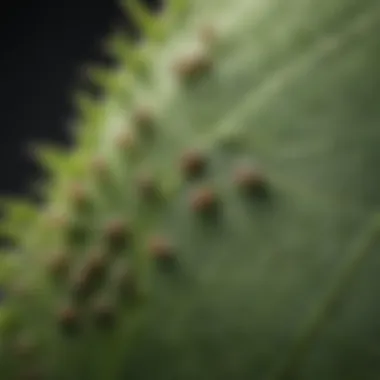
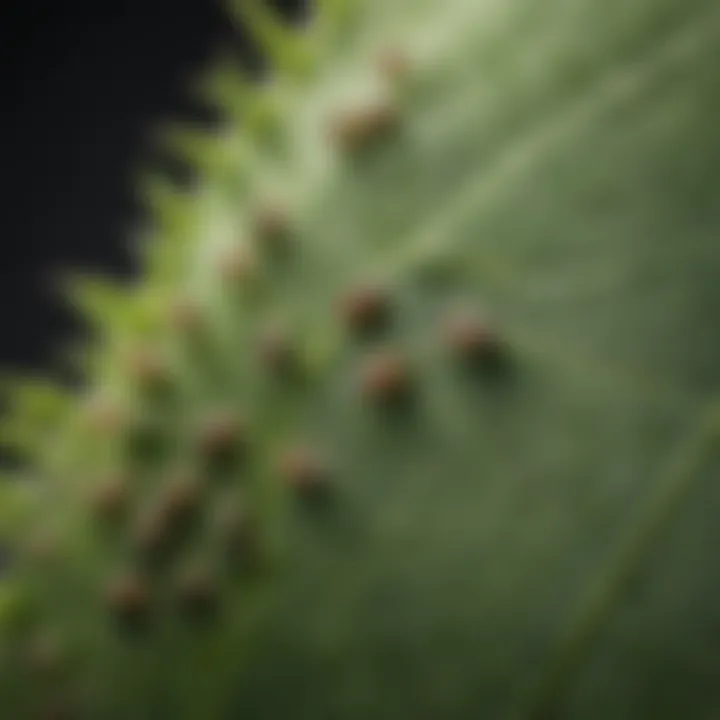
Intro
Aphids serve as a significant pest in both agriculture and horticulture, threatening the vitality of various crops and plants. This article aims to equip farmers and plant enthusiasts with actionable strategies to manage and eliminate aphid infestations effectively. By understanding the biological traits of aphids, their life cycle, and their feeding behaviors, one can employ multiple methods to combat these pests and protect agricultural viability.
Effective management requires a blend of chemical, natural, and cultural approaches, all of which will be elaborated throughout this article.
Topic Overview
Definition and Importance
Aphids are small, sap-sucking insects belonging to the family Aphididae. They can be found on numerous plants and are known for reproducing quickly, often resulting in significant population explosions under suitable conditions. Their feeding not only reduces plant vigor but can also lead to the transmission of plant viruses, which can devastate crops. Therefore, understanding their presence is critical for maintaining a robust agricultural ecosystem.
Brief History and Evolution
Historically, aphids have plagued farming practices since ancient times. These pests have evolved alongside cultivated plants, leading to complex interactions and adaptations. Farmers have always looked for effective means to control their spread. Over time, methods have advanced from rudimentary interventions to sophisticated integrated pest management (IPM) systems.
Key Techniques and Innovations
Sustainable Farming Practices
Sustainable agriculture presents effective methods for aphid management. Crop rotation, the introduction of beneficial insects, and the use of resistant plant varieties are key components of this strategy.
Benefits of Sustainable Practices:
- Minimizes chemical reliance
- Encourages ecosystem balance
- Reduces long-term costs
Advanced Agronomic Technologies
Technological innovations have transformed pest control approaches. Tools like precision agriculture enable monitoring aphid populations in real-time, helping farmers take timely actions.
Technological Tools Include:
- Drones for aerial assessments
- Soil sensors to monitor plant health
- Mobile apps for pest identification
Practical Applications
Step-by-Step Guides
When grappling with aphid infestations, following a systematic plan can yield better results. Here’s a basic guide:
- Assessment: Regularly check plants for signs of aphids.
- Identification: Use resources like Wikipedia for accurate identification.
- Selection of Treatment: Depending on severity, choose between chemical or natural methods.
- Application: Implement treatment according to product instructions.
- Monitoring: Continue to observe the plants for any resurgence of aphids.
Case Studies or Real-World Examples
Several successful tactics have emerged from real-world cases. For instance, some vineyards in California adopted natural predators to manage aphid populations, resulting in healthier grapes without applying harsh chemicals.
"Integrating natural enemies into horticulture can stabilize pest loads effectively." - Pest Management Journal
By combining these strategies, farmers can create resilient systems that withstand aphid threats while promoting sustainable practices.
Understanding Aphids
Aphids are small sap-sucking insects that can pose significant challenges to agricultural productivity. For farmers and horticultural enthusiasts, understanding aphids is crucial. This knowledge helps shape effective strategies for prevention and elimination. By grasping their biology, behavior, and the specific types that commonly invade crops, one can better prepare to tackle infestations before they escalate.
Biology and Behavior
Aphids belong to the family Aphididae and are known for their varied colors, including green, black, brown, and even red hues. They have a soft, pear-shaped body and long antennae. In terms of reproduction, aphids exhibit remarkable adaptability. They can reproduce both sexually and asexually. In favorable conditions, they give birth to live young, allowing populations to explode quickly.
Their feeding behavior is particularly damaging to plants. Aphids insert their specialized mouthparts into plant tissues and extract sap, which can lead to nutrient deficiencies. Beyond direct damage, aphids can also transmit viruses that affect plant health. Understanding their biology and behavior is essential for developing effective control strategies.


Common Species in Agriculture
Several aphid species commonly affect agriculture. The Green Peach Aphid is notorious for attacking a wide range of crops, such as peaches, peppers, and tomatoes. Another significant species is the Cotton Aphid, which thrives on cotton plants and other crops. The Pea Aphid primarily targets legumes but can spread to other plants.
Familiarity with these species allows farmers to monitor their fields for specific signs of infestation, leading to timely interventions. Each species may require different management techniques.
Impact on Crop Health
The presence of aphids can significantly undermine crop health. Their feeding habit leads to yellowing of leaves, stunted growth, and in severe cases, plant death. As sap is extracted, plants become weakened and more susceptible to diseases. This impact is not limited to visual damage.
"Aphids can reduce crop yields by as much as 50% if left unmanaged."
Moreover, the viruses carried by aphids can spread rapidly among crops, compounding the damage. Recognizing how aphids compromise plant integrity is vital for farmers aiming to maintain healthy and productive yields.
Signs of Infestation
Recognizing the signs of aphid infestation is crucial for effective pest management. Early detection leads to prompt action, minimizing damage to crops and gardens. Identifying these signs can help in understanding the pests’ impact and the necessity for intervention. The relevance of this section in the article is clear: knowing the signs allows farmers and gardeners to be proactive rather than reactive. It empowers them to protect their plants before the infestation becomes severe.
Identifying Aphid Damage
Aphids can be small in size, but their potential for damage is significant. Noticing the signs of aphid damage early can save crops from larger issues.
- Symptoms of Infestation: Leaves may curl, discolor, or appear mottled due to aphid feeding. These pests extract sap, which is vital for plant health.
- Honeydew Production: Aphids secrete a sticky substance called honeydew. This can lead to sooty mold growth, further harming the plant's photosynthesis ability.
- Presence of Ants: Sometimes, ants are seen on plants infested with aphids. They may be drawn to the honeydew, thus indicating the presence of aphids.
"Detecting aphid damage early ensures that your crops remain healthy, and it helps in implementing control measures promptly."
Assessing Infestation Levels
After identifying possible signs of aphid damage, it's essential to assess the infestation level to determine appropriate control measures.
- Visual Inspection: Regularly check the undersides of leaves and stems for clusters of aphids. Look for changes in leaf appearance.
- Population Count: Count the number of aphids on specific plants. Use a hand lens if needed for better visibility. This helps in understanding how widespread the infestation is.
- Monitoring Plants Over Time: Keep a log of plant health and aphid presence. This can assist in recognizing trends and deciding when to act.
- Thresholds for Action: Establish a threshold for when to treat infestations. This could be based on the crop type, value, and production goals.
Using these methods will help in identifying how severe the problem is. Ultimately, understanding both damage signs and infestation levels enables effective strategic planning. Regular monitoring and timely assessment lead to healthier, more productive plant yields.
Cultural Control Methods
Cultural control methods are essential strategies in managing aphid populations effectively. These approaches focus on altering farming practices to create an environment that is less conducive to aphid infestations. By implementing cultural controls, farmers can enhance the resilience of their crops and promote healthier ecosystems, thus reducing reliance on chemical interventions. Several elements are critical in understanding the significance of these methods.
One key benefit of cultural control methods is their sustainability. These practices work to improve soil and crop health while limiting pests naturally. Unlike synthetic insecticides, methods such as crop rotation or companion planting contribute to biodiversity and ecosystem stability. In addition, cultural controls often have minimal impact on beneficial insects, which are crucial for pollination and pest control. Therefore, integrating these techniques into agricultural practices can lead to long-term pest management solutions.
Crop Rotation Practices
Crop rotation involves alternating the type of crops grown in a particular area each planting season. This practice disrupts the life cycle of aphids by eliminating their preferred host plants, thereby reducing their populations. For instance, growing legumes one season and then planting brassicas the next can help manage aphids that thrive on specific crops. Moreover, rotating crops can improve soil health, as different plants contribute varying nutrients and require distinct water levels. Choosing compatible rotation strategies can be an effective way to combat aphid infestations while enhancing overall productivity.
Companion Planting Techniques
Companion planting involves strategically growing different crops in proximity for mutual benefits. Certain plants can repel aphids or attract natural predators, thus minimizing aphid populations. For example, planting garlic or chives near susceptible plants such as roses can deter aphids due to their strong scents. Additionally, flowers such as marigolds can attract beneficial insects, like ladybugs, which prey on aphids. Understanding specific combinations of plants allows farmers to create a diverse planting scheme that naturally mitigates pests and promotes plant health.
Soil Health Management
Managing soil health is another paramount cultural control method. Healthy soils lead to robust plants that can withstand aphid pressure more effectively. Practices such as adding organic matter, composting, and ensuring proper pH levels are vital. Healthy soils improve root development and moisture retention, which support plant vigor. When plants are strong, they are less susceptible to aphid attacks. Regular soil testing can help farmers tailor their nutrient inputs to foster an environment that minimizes aphid presence.
"Focus on soil health; a healthy plant is a resilient plant."
By emphasizing these cultural control methods, farmers can establish a proactive approach to aphid management while fostering a sustainable agricultural system. Overall, these methods require less synthetic intervention, promote environmental health, and lead to increased agricultural productivity.
Chemical Control Options
Chemical control options are crucial in the fight against aphids, especially when infestations escalate beyond manageable levels. These tactics help to protect crops and maintain agricultural productivity. Understanding how different chemical solutions work can empower farmers to make informed decisions, ensuring that they do not only eradicate pests but also minimize potential harm to their crops and the ecosystem.
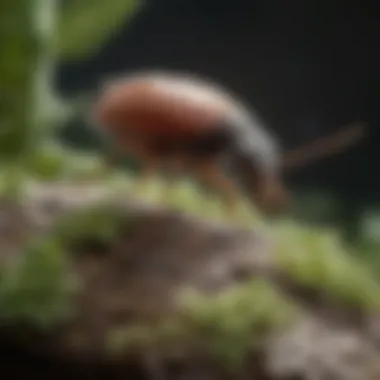

Synthetic Insecticides
Synthetic insecticides have been a cornerstone of pest management for years. They target specific pests like aphids with precision. These chemicals generally act quickly, providing immediate relief to affected plants. Common synthetic insecticides include imidacloprid and chlorpyrifos, which disrupt the nervous system of aphids, leading to their death. However, their use should be carefully considered.
One critical aspect is the potential for resistance. Over-reliance on synthetic insecticides can lead to aphids developing resistance, making them harder to control over time. Moreover, these chemicals can have adverse effects on non-target organisms, such as pollinators. This is particularly concerning, as maintaining biodiversity is essential for sustainable agriculture.
Organic Pesticides
Organic pesticides offer an alternative for those seeking eco-friendly solutions. These products often contain natural ingredients or are derived from plants, posing less risk to beneficial insects and the environment. Examples include neem oil and insecticidal soap, which are known to be effective against aphids.
Using organic pesticides has several advantages. They can break down more quickly in the environment, reducing long-term impact. Additionally, they often promote soil health and support overall ecosystem balance. However, these options require more frequent applications, as they may not provide the same immediate effects as synthetic alternatives.
Application Guidelines
Proper application of chemical controls is vital for their effectiveness and safety. Here are some guidelines to ensure effective use:
- Read Labels Thoroughly: Always review application instructions and safety precautions provided by the manufacturer.
- Timing is Key: Apply treatments when aphids are most vulnerable, typically during their early life stages.
- Target Application: Aim for infested areas to conserve beneficial insects and reduce pesticide usage.
- Weather Consideration: Avoid application before rain or heavy winds to ensure chemicals do not wash away or drift to non-target areas.
- Personal Protective Equipment (PPE): Use appropriate PPE to minimize exposure during application.
Using chemical control options effectively requires knowledge of both the products and the pest. Farmers must be proactive in adapting their strategies to changing conditions.
Chemical control options can be powerful tools in the management of aphids. However, their use requires a thoughtful approach to maximize benefits while reducing potential risks.
Biological Control Methods
Biological control methods play a critical role in managing aphid infestations. Unlike chemical approaches, these methods harness natural processes to reduce pest populations. They focus on using natural predators, beneficial insects, and microbial solutions. The importance of these strategies lies in their environmental friendliness and sustainability. By integrating biological control, farmers can often achieve long-term pest management success while minimizing the risks associated with chemicals.
Utilizing biological control methods can lead to several benefits:
- Reduction in Chemical Use: These methods decrease reliance on synthetic pesticides, which can have harmful effects on the ecosystem.
- Resilience: Natural predators are adept at adapting to the pest populations, making them a dynamic solution.
- Cost-Effectiveness: Investing in biological controls can often be more economical in the long run through reduced pest-related damages and lower spending on pesticides.
However, there are some considerations to keep in mind:
- The success of these methods depends on the existence of suitable habitats for predators and beneficial insects.
- Timing and population dynamics are critical; introducing predators too late can reduce effectiveness.
- Monitoring and evaluation of pest levels are essential to adjust strategies as needed.
Natural Predators
Natural predators are species that feed on aphids. Common examples include ladybugs, lacewings, and parasitic wasps. Each of these predators has a significant impact on aphid populations.
- Ladybugs: These beetles are voracious aphid eaters. A single ladybug can consume up to 5,000 aphids in its lifetime. Their presence often signifies a healthy ecosystem.
- Lacewing larvae: Known as “aphid lions,” these larvae can also devour large numbers of aphids. They are particularly effective in controlling population spikes.
- Parasitic wasps: These tiny wasps lay their eggs inside aphids. Once the eggs hatch, the larvae consume the aphids from the inside.
The utilization of these natural predators is not just about their presence; it is also about creating an environment that supports their population. Hiding spots and food sources are essential for maintaining their efficiency.
Beneficial Insects
Beneficial insects extend beyond just predators. Certain insects contribute to aphid control by creating unfavorable conditions for them. For instance:
- Hoverflies: These insects not only feed on nectar but their larvae are effective aphid predators.
- Bees: Indirectly, bees can assist in promoting plant health through pollination, which helps plants be more resistant to pests.
Understanding the life cycles and habits of these insects enables farmers to encourage their presence. Planting florals that attract and nurture these beneficial insects is a proactive approach.
Microbial Solutions
Microbial solutions represent another tier of biological control. These typically include beneficial microbes applied to plants that target aphids.
- Bacteria: Certain strains of Bacillus thuringiensis (Bt) can affect aphids when ingested, leading to their decline. Applying Bt needs to be done strategically to ensure that it targets aphids while protecting beneficial species.
- Fungi: Entomopathogenic fungi can also infect and kill aphids. Farmers can apply these fungi to crops, effectively reducing aphid numbers while being safe for other insects.
Integrated Pest Management (IPM)
Integrated Pest Management (IPM) stands as a foundational approach in the battle against aphids. This method integrates multiple pest control strategies to provide a sustainable and economically viable solution. The importance of IPM lies in its focus on long-term prevention, rather than a short-term fix. Farmers and horticulturalists must understand that managing aphids effectively goes beyond immediate chemical treatments. It implies a thorough understanding of the pest's life cycle, behavior, and ecological impact. This knowledge allows for the implementation of targeted methods that minimize harm to beneficial organisms and the environment while effectively controlling aphid populations.
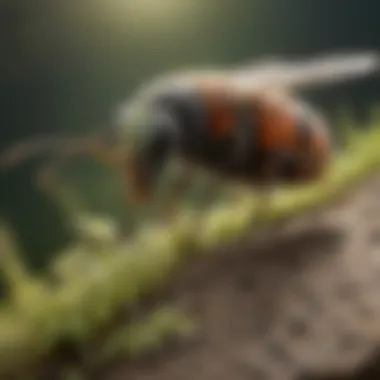
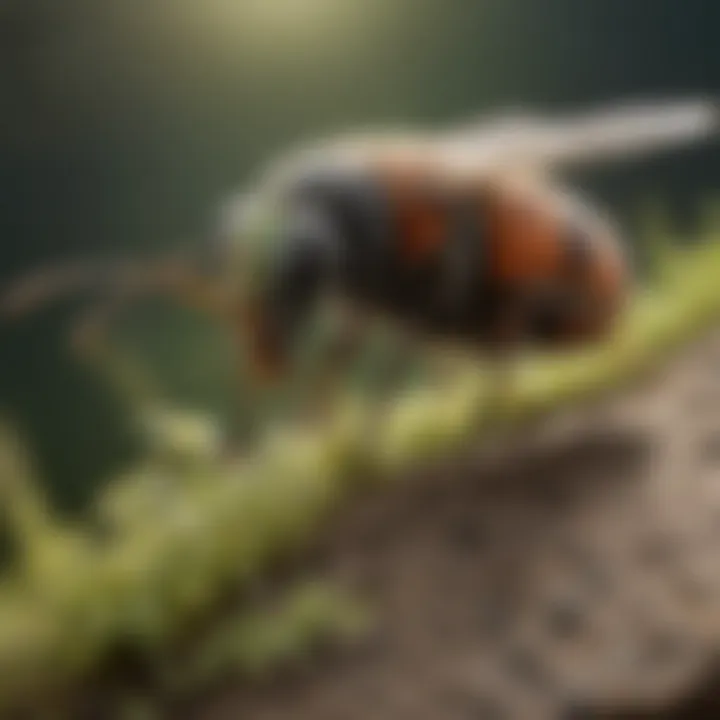
Principles of IPM
IPM is built on several core principles that guide its application. These principles include:
- Prevention: Proactive measures should be the first line of defense against aphids. This involves selecting pest-resistant plant varieties, maintaining healthy soil, and practicing crop rotation.
- Monitoring: Regular observation helps identify the presence of aphids before they reach critical infestation levels. Use of sticky traps and visual inspections can aid in noting changes in plant health.
- Identification: Correctly identifying aphid species is crucial as different species may require specific management techniques.
- Control: Using a mix of cultural, biological, and chemical controls can lead to effective management while reducing reliance on any one method.
- Evaluation: Assessing the efficacy of chosen strategies and adapting them based on outcomes is vital. Continuous improvement enhances future pest management efforts.
Monitoring and Assessment Strategies
Monitoring aphid populations and assessing infestation levels are critical in IPM. Effective monitoring strategies include:
- Regular Inspections: Periodically examine plants, especially the undersides of leaves where aphids commonly reside.
- Using Traps: Employing yellow sticky traps can help capture flying aphids and provide insights into their population levels in real-time.
- Threshold Levels: Establish action thresholds. For many crops, if aphid populations exceed a certain level, intervention is necessary.
- Data Collection: Keep detailed records of findings, including population counts and damage levels over time, to inform future decisions.
Combining Methods for Effectiveness
The strength of IPM lies in its holistic approach, where combining various methods enhances overall effectiveness. Best practices include:
- Cultural Practices: Implementing crop rotation and maintaining soil health play an essential role in overall pest management and can create unfavorable conditions for aphids.
- Biological Controls: Introducing beneficial insects like ladybugs can help naturally lower aphid numbers without chemical intervention.
- Targeted Chemical Use: When warranted, using appropriately selected control products at the right time can minimize damage while protecting beneficial organisms.
"IPM is not just about controlling pests; it's about managing ecosystems."
By integrating these principles, strategies, and methods, farmers can achieve a balanced approach to aphid management, ensuring crop health and productivity while considering economic and environmental impacts.
Preventative Measures
Preventative measures are essential in managing aphids effectively. This proactive approach not only minimizes the chances of an infestation but also reduces the reliance on chemical treatments later. By implementing robust prevention strategies, farmers and gardeners can create an environment that discourages aphids from establishing themselves. This section covers critical elements and methods of prevention.
Regular Monitoring
Monitoring is crucial in pest management. Regular inspections of plants can help in early detection of aphid populations. Observing leaves, stems, and the undersides of foliage enables farmers to spot the first signs of infestation. To enhance this process, keep a checklist of what to look for.
- Check for sticky residue: Aphids excrete a substance called honeydew, resulting in a shiny appearance on leaves.
- Look for discoloration: Yellowing leaves can indicate aphid feeding activity.
- Watch for curled leaves: Abnormal leaf shapes can be a sign of aphid damage.
Keeping a log of these observations allows for better analysis of trends and effectiveness of implemented control measures.
Plant Selection and Preparation
Choosing the right plants plays a pivotal role in preventing aphid infestations. Selecting varieties that are known for their resistance to aphids can reduce the chances of their establishment. Furthermore, healthy, vigorous plants are less susceptible to pests.
When preparing your garden, consider these factors:
- Select resistant cultivars: Some plant varieties are bred specifically to resist aphids.
- Healthy plants: Ensure the soil has sufficient nutrients for strong plant growth.
- Environmental factors: Position plants to maximize sunlight, which promotes healthier growth.
Additionally, correctly spacing plants can improve air circulation, making the environment less favorable for aphids.
Maintaining Plant Health
Overall, the health of plants is a strong deterrent against pest infestations. Regular maintenance of soil, nutrients, and water keeps plants robust.
- Fertilization: Use organic or balanced fertilizers to nourish plants. Healthy plants can withstand pests more effectively.
- Watering practices: Ensure plants receive adequate water but avoid overwatering, which can create stress.
- Pruning and hygiene: Remove dead or infected plant material to reduce hiding spots for aphids.
By maintaining optimal plant health and a clean garden, the likelihood of severe aphid infestations decreases substantially.
"Prevention is always better than cure." - Unknown
The End
Summarizing Effective Strategies
In summary, effective aphid control involves utilizing a combination of cultural, chemical, and biological methods. Regular monitoring is essential to catch infestations early. Implementing crop rotation can disrupt the life cycle of aphids, while companion plants can naturally repel them. The application of organic pesticides or targeted chemical options should be used judiciously, ensuring they are applied at optimal times. Biological controls, such as introducing natural predators, add additional layers of protection against aphids. This multi-faceted strategy ensures a healthier crop environment.
- Monitor crops regularly for aphid presence.
- Rotate crops to break life cycles.
- Use companion planting to deter aphids.
- Apply organic pesticides when necessary.
- Introduce beneficial insects to manage populations.
Future Considerations in Pest Management
As agriculture evolves, future considerations in pest management will also need to adapt to changing environmental factors. Climate change may influence insect populations, potentially increasing aphid infestations in certain areas. Additionally, the continuous development of new pest control methods, with an emphasis on sustainability and minimal environmental impact, will be key. Researchers should focus on enhancing integrated pest management practices and the development of resistant plant varieties. Collaboration between farmers, scientists, and policymakers will be crucial in shaping effective future strategies. Staying informed and proactive will enable farmers to safeguard their crops against aphid threats in the years ahead.
Proper pest management not only protects crops but also ensures sustainable agricultural practices for future generations.



